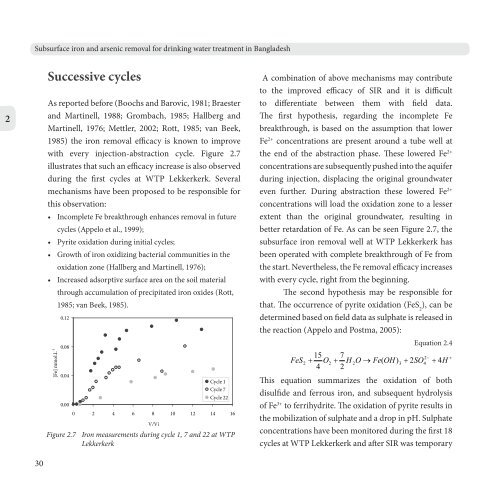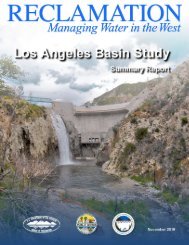Subsurface Iron and Arsenic Removal
qj78kp8
qj78kp8
- No tags were found...
Create successful ePaper yourself
Turn your PDF publications into a flip-book with our unique Google optimized e-Paper software.
<strong>Subsurface</strong> iron <strong>and</strong> arsenic removal for drinking water treatment in Bangladesh<br />
2<br />
Successive cycles<br />
As reported before (Boochs <strong>and</strong> Barovic, 1981; Braester<br />
<strong>and</strong> Martinell, 1988; Grombach, 1985; Hallberg <strong>and</strong><br />
Martinell, 1976; Mettler, 2002; Rott, 1985; van Beek,<br />
1985) the iron removal efficacy is known to improve<br />
with every injection-abstraction cycle. Figure 2.7<br />
illustrates that such an efficacy increase is also observed<br />
during the first cycles at WTP Lekkerkerk. Several<br />
mechanisms have been proposed to be responsible for<br />
this observation:<br />
• Incomplete Fe breakthrough enhances removal in future<br />
cycles (Appelo et al., 1999);<br />
• Pyrite oxidation during initial cycles;<br />
• Growth of iron oxidizing bacterial communities in the<br />
oxidation zone (Hallberg <strong>and</strong> Martinell, 1976);<br />
• Increased adsorptive surface area on the soil material<br />
[Fe] mmol.L -1<br />
through accumulation of precipitated iron oxides (Rott,<br />
1985; van Beek, 1985).<br />
0.12<br />
0.08<br />
0.04<br />
0.00<br />
0 2 4 6 8 10 12 14 16<br />
V/Vi<br />
Cycle 1<br />
Cycle 7<br />
Cycle 22<br />
Figure 2.7 <strong>Iron</strong> measurements during cycle 1, 7 <strong>and</strong> 22 at WTP<br />
Lekkerkerk<br />
A combination of above mechanisms may contribute<br />
to the improved efficacy of SIR <strong>and</strong> it is difficult<br />
to differentiate between them with field data.<br />
The first hypothesis, regarding the incomplete Fe<br />
breakthrough, is based on the assumption that lower<br />
Fe 2+ concentrations are present around a tube well at<br />
the end of the abstraction phase. These lowered Fe 2+<br />
concentrations are subsequently pushed into the aquifer<br />
during injection, displacing the original groundwater<br />
even further. During abstraction these lowered Fe 2+<br />
concentrations will load the oxidation zone to a lesser<br />
extent than the original groundwater, resulting in<br />
better retardation of Fe. As can be seen Figure 2.7, the<br />
subsurface iron removal well at WTP Lekkerkerk has<br />
been operated with complete breakthrough of Fe from<br />
the start. Nevertheless, the Fe removal efficacy increases<br />
with every cycle, right from the beginning.<br />
The second hypothesis may be responsible for<br />
that. The occurrence of pyrite oxidation (FeS 2<br />
), can be<br />
determined based on field data as sulphate is released in<br />
the reaction (Appelo <strong>and</strong> Postma, 2005):<br />
Equation 2.4<br />
15 7<br />
2<br />
FeS 4<br />
4 2<br />
− +<br />
2<br />
+ O2<br />
+ H<br />
2O<br />
→ Fe(<br />
OH )<br />
3<br />
+ 2SO4<br />
+ H<br />
This equation summarizes the oxidation of both<br />
disulfide <strong>and</strong> ferrous iron, <strong>and</strong> subsequent hydrolysis<br />
of Fe 3+ to ferrihydrite. The oxidation of pyrite results in<br />
the mobilization of sulphate <strong>and</strong> a drop in pH. Sulphate<br />
concentrations have been monitored during the first 18<br />
cycles at WTP Lekkerkerk <strong>and</strong> after SIR was temporary<br />
30



